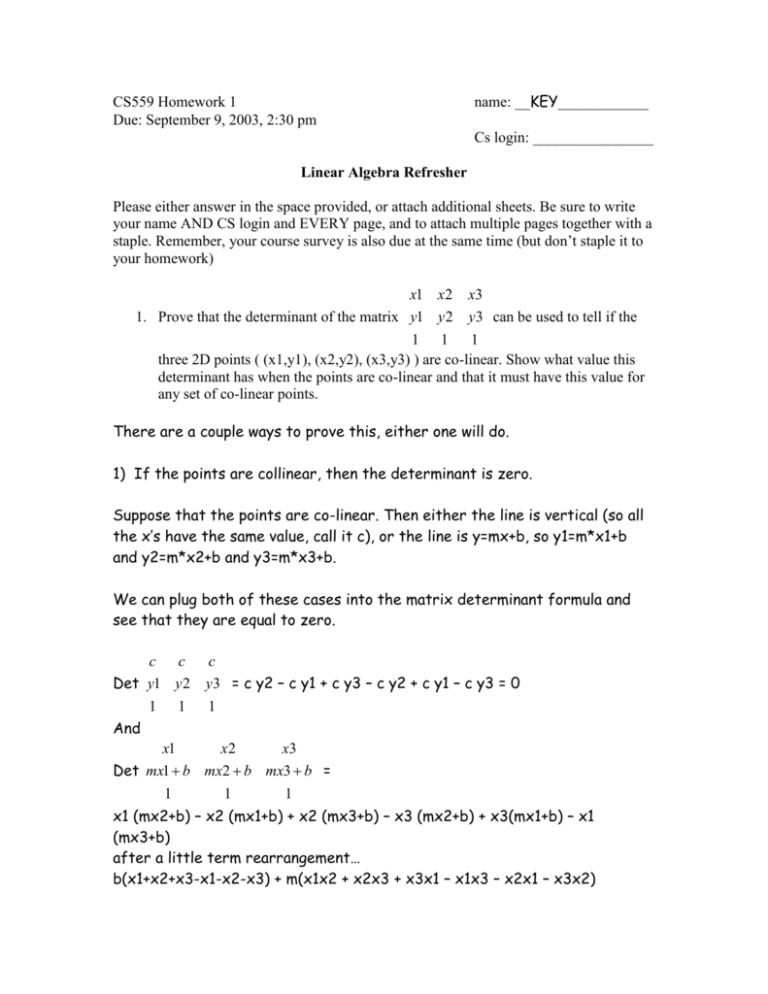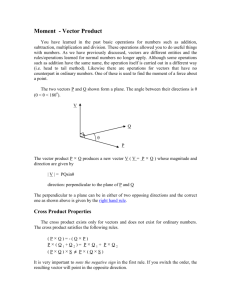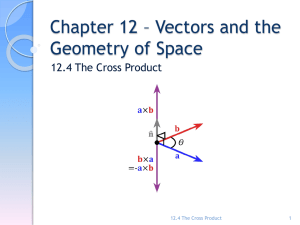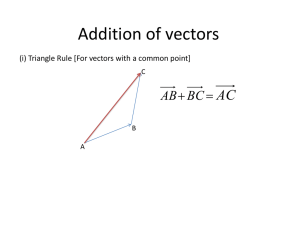Linear Algebra Refresher
advertisement

CS559 Homework 1
Due: September 9, 2003, 2:30 pm
name: __KEY____________
Cs login: ________________
Linear Algebra Refresher
Please either answer in the space provided, or attach additional sheets. Be sure to write
your name AND CS login and EVERY page, and to attach multiple pages together with a
staple. Remember, your course survey is also due at the same time (but don’t staple it to
your homework)
x1 x 2 x3
1. Prove that the determinant of the matrix y1 y 2 y3 can be used to tell if the
1 1 1
three 2D points ( (x1,y1), (x2,y2), (x3,y3) ) are co-linear. Show what value this
determinant has when the points are co-linear and that it must have this value for
any set of co-linear points.
There are a couple ways to prove this, either one will do.
1) If the points are collinear, then the determinant is zero.
Suppose that the points are co-linear. Then either the line is vertical (so all
the x’s have the same value, call it c), or the line is y=mx+b, so y1=m*x1+b
and y2=m*x2+b and y3=m*x3+b.
We can plug both of these cases into the matrix determinant formula and
see that they are equal to zero.
c c
c
Det y1 y 2 y3 = c y2 – c y1 + c y3 – c y2 + c y1 – c y3 = 0
1 1 1
And
x1
x2
x3
Det mx1 b mx2 b mx3 b =
1
1
1
x1 (mx2+b) – x2 (mx1+b) + x2 (mx3+b) – x3 (mx2+b) + x3(mx1+b) – x1
(mx3+b)
after a little term rearrangement…
b(x1+x2+x3-x1-x2-x3) + m(x1x2 + x2x3 + x3x1 – x1x3 – x2x1 – x3x2)
or 0 b + 0 m = 0
2) If the determinant is zero, then the points are collinear.
All of the line segments are connected, so to show that the points are colinear, we need to show that the slopes are the same.
Plugging x1,y1,x2,y2,x3,y3 into the determinant formula, and setting it equal
to zero, we get
x1 y2 – x2 y1 + x2 y3 – x3 y2 + x3 y1 – x1 y3 = 0
Now, a little re-arranging gives
x1y2 - x1 y3 + x2y3 = y1x2 –y1x3 + y2x3
Then the clever step, subtract x2y2 from both sides, which gives
x1y2 - x1 y3 + x2y3 –x2y2 = y1x2 –y1x3 + y2x3 –x2y2
Which can be factored into
(x1-x2) ( y2-y3) = (y1-y2) (x2-x3) **
which can be re-arranged into:
(x1-x2) / (y1-y2) = (x2-x3) / (y2-y3)
showing that the slopes are indeed the same for these two segments.
Except when the lines are horizontal (or vertical if you didn’t put the slopes
upside down as I did in the last equation), so we can’t divide by (y1-y2) or
(y2-y3) (since they’d be zero).
So supposed one of them (say y1-y2) is zero, Plug that into **, to get
(x1-x2) (y2-y3) = 0, which means either x1-x2 is zero or y2-y3 is zero. In
the former case, 2 points are in the same place, so clearly the 3 points are
collinear. In the latter case, both lines are horizontal, so their slopes are the
same.
2. Suppose we have n k by k matrices (A, B, C, …) and m k-vectors (a, b, c, …) and
that we want to compute the product of all of these matrices times each vector
(e.g. ABCa, ABCb, ABCc, …).
Clearly, for each of these products it is faster (in terms of the number of
arithmetic operations) to do the multiplies from right to left (doing a sequence of
vector/matrix multiplies) than left to right.
However, for a large enough number of vectors (m), it will be faster to compute
the product of the matrices and to multiply this matrix by each vector.
Write a condition that determines which is faster (it should be an “if” statement
involving n, m, and k.
Notice that if we have a k by k matrix, a matrix multiply is exactly the same
as doing k matrix vector multiplies. This saves us from having to count
individual adds, multiplies, and memory accesses.
If we do each vector multiplied by each matrix (the left to right method)
the time taken (in terms of number of matrix time vector multiplies) is n*m.
If we multiply all the matrices together, that takes (n-1) * k vector matrix
multiplies. Once we have this, we need to multiply it by each of the m
vectors.
So, the latter is faster if (n-1)*k+m < n*m.
3. Consider the plane (in 3 space) 2x + 2y + z = 2. What point on this plane is
closest to the origin? Does the unit sphere intersect this plane?
The vector normal to this plane is (2,2,1). The shortest path from a point to
the plane is along the normal direction (consider the triangle inequality), so
the closest point to the origin is the intersection of a line passing through
the origin in this direction and the plane. So we define the line as (2t, 2t, t),
plug this into the plane equation to get:
(4/9, 4/9, 2/9)
Since the distance from the origin to this point is (4/9)^2 + (4/9)^2 +
(2/9)^2 < 1, this point is inside the unit sphere. Therefore, the plane must
intersect the unit sphere.
4. Given 2 vectors in 3D (a,b,c) and (d,e,f), write an equation describing the set of
points that includes the origin and is perpendicular to these vectors as:
The cross product of two 3D vectors returns a 3D vector that intersects
the two vectors and is perpendicular to each of them. See p 27 of the
Shirley book for an example of computing a cross product.
(ax + by + cz) x (dx + ey + fz) = (bf–ce)x + (cd-af)y + (ae-bd)z
a. A parametric (explicit) equation (e.g. f(s) -> (x,y,z))
Read about 3D parametric lines on p 40 of the Shirley book. To write a
parametric equation, we need to know two points on the line. Two points on
the line are:
(0, 0, 0) and (bf–ce, cd-af, ae-bd)
x = (bf-ce)t
y = (cd-af)t
z = (ae-bd)t
b. An implicit equation (e.g. f(x,y,z) = s)
The implicit function (f(x,y,z) needs to have value zero if the point (x,y,z) is
on the line perpendicular to the vectors, and non-zero elsewhere. Here is one
way to construct such a function:
If x,y,z is perpendicular to a,b,c then (x,y,z) * (a,b,c) = 0
(using * for the dot product)
If d,e,f is perpendicular to a,b,c then (x,y,z) * (d,e,f) = 0
Now we need to combine these two functions - we can't just add them
(because if one is positive and the other is negative, then we will get zero).
First we square them (to make sure they are positive) and then add them.
this gives us:
f(x,y,z) = ( (x,y,z) * (a,b,c) )2 + ( (x,y,z) * (d,e,f) )2 = 0
One thing to notice here: what we've basically done is compute the distance
of the point to the object of interest. This is often the characteristic of an
implicit function. For this reason, implicit functions are sometimes called
distance fields.
5. Do problems 5 and 10 in Chapter 2 of Shirley.
5. Remember the quadratic formula from Algebra I? There are at most two
possible values for x.
x = -b + (sqrt((-b)*(-b) – 4*a*c) / (2*a)) or
x = -b - (sqrt((-b)*(-b) – 4*a*c) / (2*a))
x = {0.75 - 1.299 i , 0.75 + 1.299 i }
10. To get the gradient of f(x, y, z), find the derivative for each of the x, y,
and z expressions. The gradient of a 3 variable function is a 3 vector.
f(x,y,z) = (x2 + y - 3z3)
f’(x,y,z) = (2x, 1, -9z2)








